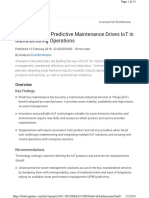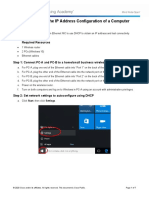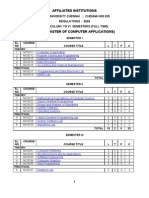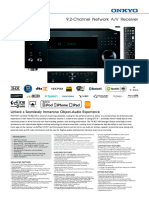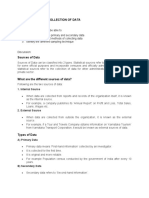452 Getting Started
452 Getting Started
Uploaded by
shusseinCopyright:
Available Formats
452 Getting Started
452 Getting Started
Uploaded by
shusseinCopyright
Available Formats
Share this document
Did you find this document useful?
Is this content inappropriate?
Copyright:
Available Formats
452 Getting Started
452 Getting Started
Uploaded by
shusseinCopyright:
Available Formats
2/13/2011
INFORMATION SYSTEMS ENGINEERING IENG 452 MOTIVATION
1
Dr. Sayed A. H. El-Sayed Spring 2011
INVESTMENTS ON IT AND
ITS IMPACT
Implementation of the microprocessor in computers and industrial controllers began in the 1970s and early 1980s. The resulting productivity gains occurred with a time lag of two decades.
In the 1990s, the number of companies investing in enterprise-
wide IT software had quadrupled - compared to the mid 1980s.
These investments have had a significant impact on:
The efficiency of resource use within companies, The relationship between companies and their suppliers and customers, The business strategies adopted by companies that use IT as a competitive tool.
2
For all these reasons, IT has become an important subject in the
academic training of engineers and industrial managers.
2/13/2011
A LITTLE HISTORY
Thirty years ago, IT was looked upon as just another labor saving tool, like any other form of mechanization. Information Systems (IS) were used in the bookkeeping and payroll functions, where computers were substituted for accountants in maintaining and summarizing financial records. In production operations, automatic control of processes based on analog electronics was being replaced by digital controllers, such as programmable logic controllers.
A LITTLE HISTORY - THE 1980S:
Integration of operations first took place by expanding business applications to include order entry, purchasing, production planning and inventory control. Managers began to focus on company processes as interrelated groups of activities across which information could be shared. On the manufacturing shop floor, developments in LANs provided the technology for gathering data from digital controllers and sensors and transmitting it to factory databases for analysis of factory operations.
4
2/13/2011
A LITTLE HISTORY - DURING THE 1990S:
Industrial managers began to view Info. Systems as a tool to improve their processes and eliminate functions that did not add value to the enterprise.
The emphasis was placed on organizational redesign. Several companies emerged with software solutions for managing industrial enterprises. These products crossed the boundaries between management functions, shop floor functions, and warehousing and distribution functions, such as supply chain management systems. Enterprise Resource Planning (ERP) software industry was born.
5
A LITTLE HISTORY - SINCE THE MID 1990S:
Software became more Internet-enabled, giving industrial firms the ability to easily integrate customer relations and supplier relations with the overall enterprise database.
Example : Some packaged food manufacturers monitor their customers inventory positions in real-time:
Checkout counters debit inventory using bar code scanning, Inventory levels can be monitored by suppliers, Suppliers can then anticipate the need for a new shipment of
product to their customer.
The use of IT motivated a strategy of flexible manufacturing operations a change in enterprise organization: e.g.
Make-to-order environment, such as that of Dell Computer, where
the Internet allows the customer to tailor the product to his or her own specification on-line.
You might also like
- Office 2013 SerialDocument36 pagesOffice 2013 SerialkrisnandarNo ratings yet
- SCM 13Document4 pagesSCM 13Gajendra Singh RaghavNo ratings yet
- Reviewer It 221 Chap 1 To 5Document26 pagesReviewer It 221 Chap 1 To 5nimfadelgado11No ratings yet
- SCM - Role of ITDocument3 pagesSCM - Role of ITWah KhaingNo ratings yet
- Introduction To Information Systems (Full) - 2 - 299643805Document111 pagesIntroduction To Information Systems (Full) - 2 - 299643805qpromaglasangNo ratings yet
- 2 - Overview of Information SystemsDocument70 pages2 - Overview of Information SystemsOsei SylvesterNo ratings yet
- Internet of Things: Madjid Tavana, Vahid Hajipour, Shahrzad OveisiDocument27 pagesInternet of Things: Madjid Tavana, Vahid Hajipour, Shahrzad OveisiFatma KarrayNo ratings yet
- IT EnvironmentDocument6 pagesIT EnvironmenthzbnzbajavxhsNo ratings yet
- Role of Information Technology in Supply Chain ManagementDocument7 pagesRole of Information Technology in Supply Chain ManagementKiran DatarNo ratings yet
- Ais in PakistanDocument7 pagesAis in PakistanMalik AdilNo ratings yet
- Role of Information Technology in Supply Chain ManagementDocument5 pagesRole of Information Technology in Supply Chain ManagementElyaas ZerdiNo ratings yet
- The Impact of Computer Technology On Accounting System and Its Effect On EmploymentDocument116 pagesThe Impact of Computer Technology On Accounting System and Its Effect On EmploymentBhupendra JoshiNo ratings yet
- Role of Information Technology in Supply Chain ManagementDocument4 pagesRole of Information Technology in Supply Chain ManagementLeena BhapkarNo ratings yet
- Week OneDocument8 pagesWeek OneAzin RostamiNo ratings yet
- Role of Information Technology in Supply Chain ManagementDocument4 pagesRole of Information Technology in Supply Chain ManagementKanika Chaudhary100% (1)
- The Impact of Computer Technology On Accounting System and Its Effect On EmploymentDocument25 pagesThe Impact of Computer Technology On Accounting System and Its Effect On EmploymentFarhan JagirdarNo ratings yet
- The Impact of Information Technology On Accounting and Finance 1Document12 pagesThe Impact of Information Technology On Accounting and Finance 1Samsung IphoneNo ratings yet
- The Impact of Computer Technology On Accounting System and Its Effect On EmploymDocument84 pagesThe Impact of Computer Technology On Accounting System and Its Effect On Employmcloud9digitalsNo ratings yet
- Ch01 PPTrevisedDocument49 pagesCh01 PPTrevisedFelicity LouvreNo ratings yet
- Banking SectorDocument8 pagesBanking Sectorvishal thomkeNo ratings yet
- Industry 4.0: Is Your ERP System Ready For The Digital Era?Document40 pagesIndustry 4.0: Is Your ERP System Ready For The Digital Era?Erandika Lakmali GamageNo ratings yet
- Introduction To Systems Analysis and DesignDocument48 pagesIntroduction To Systems Analysis and DesignNisreen InnabNo ratings yet
- Chapter 1Document78 pagesChapter 1hmundleNo ratings yet
- Submitted By: Submitted ToDocument5 pagesSubmitted By: Submitted ToRakshya NepaliNo ratings yet
- Information Systems in Business Today: Facts & Figures (United States)Document19 pagesInformation Systems in Business Today: Facts & Figures (United States)Aali YahNo ratings yet
- Dr. Samim Al Azad (SAA2) : Chapter-1: Information Systems in Business TodayDocument29 pagesDr. Samim Al Azad (SAA2) : Chapter-1: Information Systems in Business TodayNirob AlecNo ratings yet
- Iiot-Ready' Machine: Essentials of TheDocument8 pagesIiot-Ready' Machine: Essentials of TheRachiahi TarikNo ratings yet
- AUDCISDocument50 pagesAUDCIS뿅아리No ratings yet
- An Overview On ERP - Chapter 1Document26 pagesAn Overview On ERP - Chapter 1Puneet BansalNo ratings yet
- What Is Business AnalyticsDocument109 pagesWhat Is Business AnalyticsBhumitra DeyNo ratings yet
- Production and Performance ManagementDocument12 pagesProduction and Performance ManagementhidehelpNo ratings yet
- Mini Project 2Document34 pagesMini Project 2muskanbano4101No ratings yet
- 1.importance of ISDocument35 pages1.importance of ISAmewu Mensah EmmanuelNo ratings yet
- MIS-3 Handout PDFDocument3 pagesMIS-3 Handout PDFRaphael Pepiton IslaNo ratings yet
- Chp-01 The Evolving Role of IS and Technology in Organizations - A Strategic PerspectiveDocument33 pagesChp-01 The Evolving Role of IS and Technology in Organizations - A Strategic PerspectiveAyu SorayaNo ratings yet
- Management Information SystemDocument100 pagesManagement Information Systemnehaiimt100% (1)
- Winter Big Data 1438533Document8 pagesWinter Big Data 1438533karanmahajanNo ratings yet
- Information Technology A New Competitive WeaponDocument17 pagesInformation Technology A New Competitive Weaponabha vermaNo ratings yet
- 15 Digitizing Operational Processes ForresterDocument33 pages15 Digitizing Operational Processes Forrestersergio100% (1)
- 7233M - S1 - R0Document49 pages7233M - S1 - R0Radenda Manggala MustikasalehNo ratings yet
- History of ICTDocument10 pagesHistory of ICTJaydeep KushwahaNo ratings yet
- Q.1 Explain The Importance of Business Forecasting. List & Explain The Steps in The PERT Planning ProcessDocument18 pagesQ.1 Explain The Importance of Business Forecasting. List & Explain The Steps in The PERT Planning ProcessSurjith RaufNo ratings yet
- The Impact of Computer Technology On Accounting System and Its Effect On EmploymentDocument22 pagesThe Impact of Computer Technology On Accounting System and Its Effect On EmploymentSmith JosephNo ratings yet
- Unit 4 - 2Document111 pagesUnit 4 - 2125009941No ratings yet
- Ict and Bussness Management Cours Level2 Iai 2024Document23 pagesIct and Bussness Management Cours Level2 Iai 2024Hermann CHEMEUHINo ratings yet
- How Does Modern Business Influence Information Systems?: New Products and ServicesDocument4 pagesHow Does Modern Business Influence Information Systems?: New Products and ServicesTeja MullapudiNo ratings yet
- Enterprise Resource PlanningDocument26 pagesEnterprise Resource PlanningHemal Patel SamNo ratings yet
- GROUP 6 - IT Specific in Accountancy PDFDocument8 pagesGROUP 6 - IT Specific in Accountancy PDFashley samonteNo ratings yet
- Data Analytics: A Key Component of Digital TransformationDocument23 pagesData Analytics: A Key Component of Digital TransformationStanislaus AdityaNo ratings yet
- Digital Manufacturing EnterpriseDocument5 pagesDigital Manufacturing EnterpriseliparyanNo ratings yet
- Gartner - APM Market TrendDocument14 pagesGartner - APM Market TrendkarimmebsNo ratings yet
- ERP1Document141 pagesERP1Kaikala Ram Charan TejNo ratings yet
- Enterprise Resource PlanningDocument5 pagesEnterprise Resource PlanningkavithagowriNo ratings yet
- Role of Information Technology in Supply Chain ManagementDocument24 pagesRole of Information Technology in Supply Chain ManagementMadhu ShrivastavNo ratings yet
- Introduc0on To Systems Analysis and DesignDocument49 pagesIntroduc0on To Systems Analysis and DesignCGNo ratings yet
- 10 Must Watch FuturisticDocument6 pages10 Must Watch FuturisticSannena GovindaNo ratings yet
- Assignments OmegaDocument7 pagesAssignments OmegaJulianNo ratings yet
- Do It Smart: Seven Rules for Superior Information Technology PerformanceFrom EverandDo It Smart: Seven Rules for Superior Information Technology PerformanceRating: 3 out of 5 stars3/5 (1)
- Book Series: Increasing Productivity of Software Development, Part 1: Productivity and Performance Measurement - Measurability and MethodsFrom EverandBook Series: Increasing Productivity of Software Development, Part 1: Productivity and Performance Measurement - Measurability and MethodsNo ratings yet
- Choice Books Gpa, Points Radius : Char Int Float Double Int Int Int FloatDocument1 pageChoice Books Gpa, Points Radius : Char Int Float Double Int Int Int FloatshusseinNo ratings yet
- Pds Fall2003Document52 pagesPds Fall2003shusseinNo ratings yet
- NIST IR 7290 PP MobileFprint FinalDocument23 pagesNIST IR 7290 PP MobileFprint FinalshusseinNo ratings yet
- Grade CenterDocument11 pagesGrade CentershusseinNo ratings yet
- 2011 TCNA Handbook For Ceramic, Glass, and Stone Tile InstallationDocument108 pages2011 TCNA Handbook For Ceramic, Glass, and Stone Tile InstallationLuis Gabriel BautistaNo ratings yet
- Lab - Determining The IP Address Configuration of A ComputerDocument7 pagesLab - Determining The IP Address Configuration of A ComputershabeerNo ratings yet
- Grade 8 - Unit 5 - Bài ÔnDocument5 pagesGrade 8 - Unit 5 - Bài ÔnMinh TuấnNo ratings yet
- Fontspec CodeDocument138 pagesFontspec CodeKnuth KnuthNo ratings yet
- VodafoneGlobalEnterprise Whitepaper Mobile SecurityDocument8 pagesVodafoneGlobalEnterprise Whitepaper Mobile Securityatta phoNo ratings yet
- Introduction of UI - UXDocument42 pagesIntroduction of UI - UXViru Patel100% (2)
- WX Team: One Platform - Up To Every ChallengeDocument40 pagesWX Team: One Platform - Up To Every Challengeh_878236333No ratings yet
- MCA Syllabus Regulation 2009 Anna UniversityDocument61 pagesMCA Syllabus Regulation 2009 Anna UniversityJGPORGNo ratings yet
- AyushEditz YT Pterodactyl PanelDocument3 pagesAyushEditz YT Pterodactyl Panelpythoncode1212No ratings yet
- Entrepreneur ManualDocument9 pagesEntrepreneur ManualcontactNo ratings yet
- Ip Services 6300-6400 ArubaDocument234 pagesIp Services 6300-6400 Arubagusdelamora520No ratings yet
- TX-RZ1100 DatasheetDocument2 pagesTX-RZ1100 DatasheetSuperAudio SuperAudioNo ratings yet
- Homework Solutions - X - MOP (Blue-Black) 2012Document5 pagesHomework Solutions - X - MOP (Blue-Black) 2012Ayush AryanNo ratings yet
- Eurekalog Code ReferenceDocument619 pagesEurekalog Code ReferenceShinigami RavenNo ratings yet
- Cyber Security Attacks - TorresDocument4 pagesCyber Security Attacks - Torresmark.murasaki.chanNo ratings yet
- 2016ps79 Iot ProjectDocument50 pages2016ps79 Iot ProjectpumaNo ratings yet
- Designer Client Guide: Ibm Infosphere Datastage and QualitystageDocument3 pagesDesigner Client Guide: Ibm Infosphere Datastage and QualitystagemychelriosNo ratings yet
- Zeyad Elbliety - AWS CloudDocument4 pagesZeyad Elbliety - AWS CloudvalandecentrapriseNo ratings yet
- Week 4-6 Lessons: Collection of DataDocument8 pagesWeek 4-6 Lessons: Collection of Databernadeth salmoroNo ratings yet
- Design and Implementation of Security Based ATM Theft Monitoring SystemDocument8 pagesDesign and Implementation of Security Based ATM Theft Monitoring SystemAkmal KhanNo ratings yet
- Current LogDocument46 pagesCurrent LogSamuel Betobaye DjikoinguéNo ratings yet
- 15 - PDFsam - Think Python, 2nd Edition How To Thin... (Z-Library)Document3 pages15 - PDFsam - Think Python, 2nd Edition How To Thin... (Z-Library)sehisaj962No ratings yet
- Ex - No:9 Implement An Application That Writes Data To The SD CardDocument8 pagesEx - No:9 Implement An Application That Writes Data To The SD CardAshish KulhariNo ratings yet
- Part A - List of Risks, Threats, and Vulnerabilities Commonly Found in An IT InfrastructureDocument4 pagesPart A - List of Risks, Threats, and Vulnerabilities Commonly Found in An IT InfrastructureNguyen Viet Quang Vu (K15 HCM)No ratings yet
- Unit 1 Introduction To Data Information & KnowledgeDocument40 pagesUnit 1 Introduction To Data Information & KnowledgeYashvi ManiarNo ratings yet
- Configuration Pfsense DocumentationDocument3 pagesConfiguration Pfsense DocumentationJohn WilliamsNo ratings yet
- hAP Ac Lite QG W - 200106Document7 pageshAP Ac Lite QG W - 200106AnteNo ratings yet
- The BI Based OrganizationDocument16 pagesThe BI Based OrganizationWellington Eduardo FerreiraNo ratings yet
- TM Cart Customer UI DocumentDocument11 pagesTM Cart Customer UI DocumentAlan GeorgeNo ratings yet
- 2017 Summer Model Answer PaperDocument27 pages2017 Summer Model Answer Paper1517- Damayanti DharmikNo ratings yet


















































